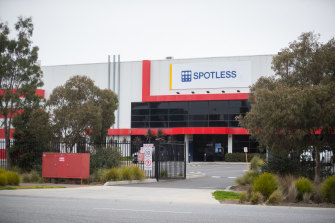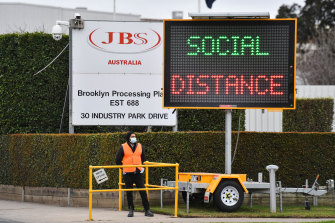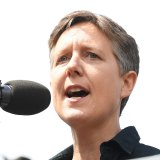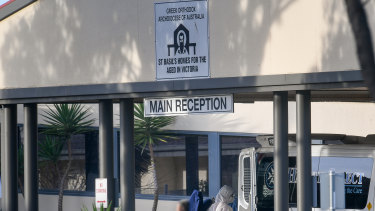At the Spotless industrial laundry in Melbourne’s south-east, employees sort through soiled linen by hand as it moves down a conveyor belt and into giant washing machines. In a pandemic, when some of the sheets and pillowslips come from hospitals and aged care centres where COVID-19 is running rampant, this is frontline work.
In late July, a number of these workers were struck down with the disease. Their colleagues, alarmed, wanted the laundry closed.

Spotless industries in Dandenong.Credit:Simon Schluter
Spotless refused, seeking instead to limit the closure to one small section of the plant. So keen was the company to continue production, it offered $50 gift vouchers to those who kept working after about half the shift, or 35 workers, walked off the job. Then it took the employees' union to the Fair Work Commission to try to get the workers back.
For the Spotless employees, many of whom are migrants and in casual work, it's a dilemma that has been at the core of Victoria’s COVID-19 outbreak for workers in low-paid and insecure work.
“Do we stand up for our rights or do we worry about our income?” said one Spotless worker who asked not to be named because they feared losing their job.
Political leaders including Prime Minister Scott Morrison and Premier Daniel Andrews insist we’re “all in this together”. But the responsibility to follow the rules – to stay at home, to avoid work – falls heavily on individuals.
Now, new analysis by The Sunday Age and The Sun-Herald that matches geography with demography and the disease burden shows clearly that COVID-19 is not affecting us all the same.
Melbourne is a city divided. Of its five most disadvantaged municipalities, four of them have the most active COVID-19 cases. The fifth disadvantaged area is Dandenong, where the Spotless laundry is. In Brimbank, in Melbourne's west the number of active cases is in excess of 800 - that's more than 10 times the level of Boroondara in the leafy inner east.
These five areas are also where the most insecure work is. It is minimum wage workers, often migrants, and often in contingent or casual jobs who are suffering unduly from the disease.
They are repeatedly told to follow government rules but can also be under pressure from their economic circumstances and their employers to risk their own health as well as that of their families and those they work with.
'Churning through workplaces'
The seeds of COVID-19 in Melbourne might have been sown first among skiers and international travellers, but since the hotel quarantine system infected poorly-paid and sessional security guards, it’s Melbourne’s working-class west and north-west where the pandemic has taken root.
It spread from security guards to their families in suburbs where often young migrant families juggle multiple jobs to pay off home loans and other bills. It got into the close-quarters workstations of meatworks, which are mostly located in the same areas and staffed by a similar demographic of workers. Several abattoirs have had serious outbreaks.
And it’s infiltrated aged care, where casual, low-paid personal care assistants are likely to have brought it in and then worked across numerous homes to try to earn a full income. There it has infected thousands, killed 125 and pushed the whole city under a severe lockdown and curfew.
The pandemic has exposed fault lines in Melbourne that cut across geographic, class and ethnic disparities.
The city’s outer north and west, Whittlesea, Brimbank, Hume, and Melton all rank in the top five areas for active COVID-19 cases, and they are also four of the five most disadvantaged municipalities in Melbourne, according to a Bureau of Statistics index. That index measures disadvantage based on a range of Census data including income, education, overcrowded housing and health.

Major meatworks including JBS in Brooklyn have been linked to COVID-19 clusters.Credit:Joe Armao
Census data shows people in these areas are much more likely than other Victorians to be born overseas and to work in trades, road transport, or as labourers – jobs that cannot be done at home. They are far less likely to work as managers or in professions.
An analysis for The Sunday Age by respected researchers SGS Economics & Planning found that the distribution of casual workers across Melbourne also broadly maps the pattern of socio-economic disadvantage.
Casual workers or those in other types of temporary work don’t have paid sick leave. If they can’t work they don’t get paid, and if they can’t make a shift for whatever reason, they may not be offered another one.
“For many workers, casualisation will mean churning through multiple workplaces and sectors in compiling their required income quota for the week,” says SGS partner, Dr Marcus Spiller.
“This, in turn, is likely to mean more face-to-face contact with employers, customers and clients per hour worked compared to the average employee. On the face of it, this ... will render these workers at greater COVID risk.
"This appears to be borne out by the pattern of confirmed cases of COVID-19 in Melbourne.”
A trend towards flexibility
Since the early 1990s recession, Australia’s long boom has benefited many. But the effect of deregulation, de-unionisation and shifting economic patterns is written on the city.
The Australian Industry Group’s Innes Willox says it’s a “myth” that insecure work is rising, adding that many people are happy to work in casual or part-time jobs as the flexibility suits them.
And it’s true that by some measures of insecure work it is relatively stable, though the extent of that remains hotly disputed by unions and employer groups. But it has stabilised at a much higher level than in the past.
In 1984, casual work made up about 15 per cent of the workforce in Australia. Now there are 650,000 Victorians who work without paid leave, according to the Australian Bureau of Statistics, a slightly lower proportion of the workforce than Australia as a whole, where 24.3 per cent are without paid leave. Australia has among the highest levels of non-full time work in the OECD.

ACTU secretary Sally McManus: “People who are less secure are more likely to go to work if they've got symptoms.”Credit:Julian Smith
In the coronavirus-ravaged northern and western suburbs, the rate of casual employment is between 25 and 35 per cent, the SGS analysis shows, with a particular peak in the hard-hit outer west.
ACTU secretary Sally McManus tells The Sunday Age and The Sun-Herald the virus “found a weakness” there.
“It was the contracting out model in the quarantine area, and it’s spread in areas where there’s a higher level of insecurity,” she says. Ms McManus notes a similar pattern overseas. The United States provides a graphic example of where poorer people, in particular minorities, are much more likely to die.
“People who are less secure are more likely to go to work if they've got symptoms. They’re facing different choices to other people in the pandemic. They're not all equal choices.”
The Health Services Union has studied three major COVID-19 outbreaks in aged care centres in Victoria, Tasmania and NSW, including St Basil’s in Melbourne’s north-west.
“In every state and in every major outbreak in residential aged care the same workplace issues have been at play,” said the union’s national secretary Lloyd Williams. “People work across multiple sites and make the decision to go to work sometimes with minor symptoms because they’re trying to subsidise what is not a living wage.”

St Basil's aged care home in FawknerCredit:Justin McManus
One of the keys to understanding poor pay and conditions in aged care is gender. Upwards of 90 per cent of aged care workers in both residential and home care are women and, according to RMIT University’s Professor Sara Charlesworth, their wages are “demeaning”.
“We undervalue this work because it looks like the kind of work women have traditionally done for free,” she says.
Professor Charlesworth says the pandemic, has laid bare major failings in a sector that should be, but isn’t, prepared for major health crises. “We need staffing for the regular irregularities of aged care.”
The HSU has warned that disability services are another COVID-19 “ticking time bomb” with union members reporting about 19 of approximately 1000 group homes affected to date.
A shift in mood?
After decades of union campaigning on insecure work with only limited effect, Ms McManus senses a shift in mood since the huge wave of hospitality and casual lay-offs in March.
“What has changed in the pandemic is the absolute experience of, and the absolute brutality of insecure work. All the jobs that were let go [when the pandemic began] were casual jobs, because they could be.
“There's been a shift in consciousness in the public. ‘Is this actually what we want?’ At certain times in history, people say this can't happen again. That's possibly the start of the thinking now.” However, the ACTU leader says change would only come from a “national consensus” on the issue.
In the face of the coronavirus storm, the Morrison government has itself proved flexible – its acceptance of public debt to pay for the giant JobKeeper scheme is one example.
But it has been reluctant so far to move on the matter of insecure work. It took until last week for the government to offer to pay $1500 a fortnight in pandemic leave, nearly two months after the Victorian government introduced its own scheme. Treasurer Josh Frydenberg, meanwhile, has pointed to Margaret Thatcher and Ronald Reagan to argue that a key component of the economic recovery will be further workplace deregulation.
The Australian Industry Group’s Mr Willox says increased workplace flexibility is “essential” to allow the economy to grow after the crisis, including simpler awards and less regulation around bargaining. Talks are currently under way between government, unions and employers.

Treasurer Josh Frydenberg wants to see changes to industrial relations lawsCredit:Alex Ellinghausen
Unions argue, though, that flexibility is part of the problem, as code for more casual or temporary work, less security of tenure.
At Spotless, the workers, worried about their health, took matters into their own hands and refused to start their shift.
Spotless’ position was equally clear: they did not want work to stop. They took the union to the Fair Work Commission, the company’s spokeswoman said, in “order that industrial action taken by the United Workers Union stop”.
If Spotless had won, then stopping work for safety reasons during the pandemic would have been ruled unlawful. But the decision for Fair Work was made for them: the Department of Health and Human Services shut the whole facility for two weeks. Four workers at Spotless, including a labour hire employee, now have the virus, though it is not thought the virus spread from soiled sheets.
Asked about the $50 vouchers handed out to encourage people to complete their shift, a Spotless spokeswoman said management offered the vouchers to workers “in recognition of their commitment during a challenging time”, and to reward their demonstration of company’s values such as “zero harm (safety), delivery, relationships, thought leadership”.
She did not respond to claims by workers that they were threatened with “consequences” if they did not work.
The Spotless worker said: “We made it clear that we do not want to transport the virus to our families.
“All of us are from different cultural backgrounds and we live in extended families. We have family members who are in the risk groups.”
Ben Schneiders is an investigative journalist at The Age and has reported extensively on the underpayment of wages, corruption, business, politics and the labour movement. His reporting has won a number of major honours including Walkley awards. He has been part of The Age’s investigative unit since 2015.
Royce Millar is an investigative journalist at The Age with a special interest in public policy and government decision-making.
https://news.google.com/__i/rss/rd/articles/CBMiiwFodHRwczovL3d3dy50aGVhZ2UuY29tLmF1L25hdGlvbmFsL3ZpY3RvcmlhL2EtY2l0eS1kaXZpZGVkLWNvdmlkLTE5LWZpbmRzLWEtd2Vha25lc3MtaW4tbWVsYm91cm5lLXMtc29jaWFsLWZhdWx0LWxpbmVzLTIwMjAwODA3LXA1NWppMi5odG1s0gGLAWh0dHBzOi8vYW1wLnRoZWFnZS5jb20uYXUvbmF0aW9uYWwvdmljdG9yaWEvYS1jaXR5LWRpdmlkZWQtY292aWQtMTktZmluZHMtYS13ZWFrbmVzcy1pbi1tZWxib3VybmUtcy1zb2NpYWwtZmF1bHQtbGluZXMtMjAyMDA4MDctcDU1amkyLmh0bWw?oc=5
2020-08-08 13:30:00Z
CAIiEFpE-dE4moi4RWWoFsQrUy0qGQgEKhAIACoHCAowgNjvCjCC3s8BMKCtmwY
Bagikan Berita Ini














0 Response to "A city divided: COVID-19 finds a weakness in Melbourne's social fault lines - The Age"
Post a Comment